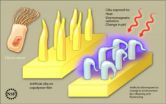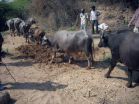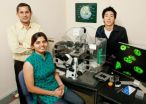(Press-News.org) Like a well-crafted football play designed to block the opposing team's offensive drive to the end zone, the body constantly executes complex 'plays' or sequences of events to initiate, or block, different actions or functions.
Scientists at the University of Rochester Medical Center recently discovered a potential molecular playbook for blocking cardiac hypertrophy, the unwanted enlargement of the heart and a well-known precursor of heart failure. Researchers uncovered a specific molecular chain of events that leads to the inhibition of this widespread risk factor.
The new research, published in Proceedings of the National Academy of Sciences, is a concept study in the very early stages of investigation and has yet to be examined in animal models. Nonetheless, it represents a new avenue of exploration for scientists working to find ways to prevent and treat cardiac hypertrophy and heart failure.
"While our findings are still in the beginning phases, they are important because heart failure is a major cause of human disease and death, and it remains very hard to treat," said Zheng-Gen Jin, Ph.D., associate professor within the Aab Cardiovascular Research Institute at the Medical Center and lead author of the study. "One of the main treatments for heart failure, beta blockers, has huge side effects, such as increased fatigue and depression, so scientists need to continue to look for new ways to care for patients with the disease."
The playbook begins with a key protein, histone deacetylase 5, or HDAC5, one of several proteins that influences gene expression – the process by which genes are turned on and converted into proteins that carry out the body's functions. The location of HDAC5, in conjunction with other factors, helps determine whether or not gene expression takes place: If HDAC5 is pushed outside the nucleus, genes are turned on and proteins are made, but if it remains inside the nucleus genes are suppressed.
The major finding and linchpin in the playbook is the action of PKA, an enzyme that researchers found changes the composition of HDAC5, keeping it inside the nucleus of heart muscle cells and stopping the expression of cardiac fetal or cardiac growth genes – genes that spur the growth of a newly developing heart in a fetus, but also cause the growth of unwanted heart muscle cells in adults, making the organ bigger and thicker than it should be.
Researchers also believe PKA helps counteract stress signals, such as from high blood pressure, which interact with and typically boot HDAC5 out of the nucleus, clearing the way for the expression of cardiac growth genes and the subsequent development of heart muscle cells that lead to the enlargement of the heart.
Cardiac hypertrophy usually occurs when there is added stress on the heart. The most common cause of hypertrophy is hypertension, or high blood pressure, which forces the heart to work harder to pump blood throughout the body, causing the muscle to thicken over time. When the heart is enlarged, it does not work as efficiently as it should and can lead to heart failure.
According to Jin, next steps include animal studies to determine if keeping HDAC5 in the nucleus through PKA signaling stops cardiac hypertrophy in mice. Findings may reveal the HDAC5/PKA interaction as a viable target for drug therapy to treat cardiac hypertrophy and heart failure. Researchers have filed a patent application for the concept that is currently pending.
"Jin and his team have defined a new, potentially drugable target for treating cardiac hypertrophy, yet much more research is needed to determine if the findings hold beyond the current study," said Joseph Miano, Ph.D., associate director of the Aab Cardiovascular Research Institute.
INFORMATION: The study was funded by the National Institutes of Health. In addition to Jin, Chang Hoon Ha, Ph.D., Ji Young Kim, Ph.D., Jinjing Zhao, M.D., Ph.D., Weiye Wang, M.S., Bong Sook Jhun, Ph.D., and Chelsea Wong from the University of Rochester Medical Center contributed to the research.
END
Troy, N.Y. – Individuals within a networked system coordinate their activities by communicating to each other information such as their position, speed, or intention. At first glance, it seems that more of this communication will increase the harmony and efficiency of the network. However, scientists at Rensselaer Polytechnic Institute have found that this is only true if the communication and its subsequent action are immediate.
Using statistical physics and network science, the researchers were able to find something very fundamental about synchronization and coordination: ...
In research led by a Saint Louis University surgeon, investigators found that women who give birth after suffering pelvic fractures receive C-sections at more than double normal rates despite the fact that vaginal delivery after such injuries is possible. In addition, women reported lingering, yet often treatable, symptoms following their pelvic fracture injuries, from urinary complications to post-traumatic stress disorder.
The study, published in Clinical Orthopaedics and Related Research, retrospectively reviewed the cases of 71 women who had suffered pelvic fractures, ...
PASADENA, Calif.—Computers, light bulbs, and even people generate heat—energy that ends up being wasted. With a thermoelectric device, which converts heat to electricity and vice versa, you can harness that otherwise wasted energy. Thermoelectric devices are touted for use in new and efficient refrigerators, and other cooling or heating machines. But present-day designs are not efficient enough for widespread commercial use or are made from rare materials that are expensive and harmful to the environment.
Researchers at the California Institute of Technology (Caltech) ...
RENO, Nev. – Like the little engine that could, the University of Nevada, Reno experiment to transform wastewater sludge to electrical power is chugging along, dwarfed by the million-gallon tanks, pipes and pumps at the Truckee Meadows Water Reclamation Facility where, ultimately, the plant's electrical power could be supplied on-site by the process University researchers are developing.
"We are very pleased with the results of the demonstration testing of our research," Chuck Coronella, principle investigator for the research project and an associate professor of chemical ...
WASHINGTON– In recent decades, the rate at which humans worldwide are pumping dry the vast underground stores of water that billions depend on has more than doubled, say scientists who have conducted an unusual, global assessment of groundwater use.
These fast-shrinking subterranean reservoirs are essential to daily life and agriculture in many regions, while also sustaining streams, wetlands, and ecosystems and resisting land subsidence and salt water intrusion into fresh water supplies. Today, people are drawing so much water from below that they are adding enough ...
University of Southern Mississippi scientists recently imitated Mother Nature by developing, for the first time, a new, skinny-molecule-based material that resembles cilia, the tiny, hair-like structures through which organisms derive smell, vision, hearing and fluid flow.
While the new material isn't exactly like cilia, it responds to thermal, chemical, and electromagnetic stimulation, allowing researchers to control it and opening unlimited possibilities for future use.
This finding is published in today's edition of the journal Advanced Functional Materials. The ...
Archaeologists who interpret Stone Age culture from discoveries of ancient tools and artifacts may need to reanalyze some of their conclusions.
That's the finding suggested by a new study that for the first time looked at the impact of water buffalo and goats trampling artifacts into mud.
In seeking to understand how much artifacts can be disturbed, the new study documented how animal trampling in a water-saturated area can result in an alarming amount of disturbance, says archaeologist Metin I. Eren, a graduate student at Southern Methodist University, Dallas, and ...
University of California, Berkeley, and Yale University scientists have recreated the tremendous pressures and high temperatures deep in the Earth to resolve a long-standing puzzle: why some seismic waves travel faster than others through the boundary between the solid mantle and fluid outer core.
Below the earth's crust stretches an approximately 1,800-mile-thick mantle composed mostly of a mineral called magnesium silicate perovskite (MgSiO3). Below this depth, the pressures are so high that perovskite is compressed into a phase known as post-perovskite, which comprises ...
CHAMPAIGN, Ill. — Researchers report this month that MALAT1, a long non-coding RNA that is implicated in certain cancers, regulates pre-mRNA splicing – a critical step in the earliest stage of protein production. Their study appears in the journal Molecular Cell.
Nearly 5 percent of the human genome codes for proteins, and scientists are only beginning to understand the role of the rest of the "non-coding" genome. Among the least studied non-coding genes – which are transcribed from DNA to RNA but generally are not translated into proteins – are the long non-coding RNAs ...
The fifteenth tropical depression of the Atlantic Ocean season has formed in the south-central Caribbean Sea, and the GOES-13 satellite captured its swirling mass of clouds and showers in a visible image today. Watches and warnings are already up for Central America.
At 2 p.m. EDT today, Sept. 23, Tropical Depression 15 had maximum sustained winds near 35 mph. It was located about 485 miles east of Puerto Cabezas, Nicaragua, near 13.9 North and 76.2 West. It was moving west at 15 mph, and had a minimum central pressure of 1007 millibars.
The government of Nicaragua ...








